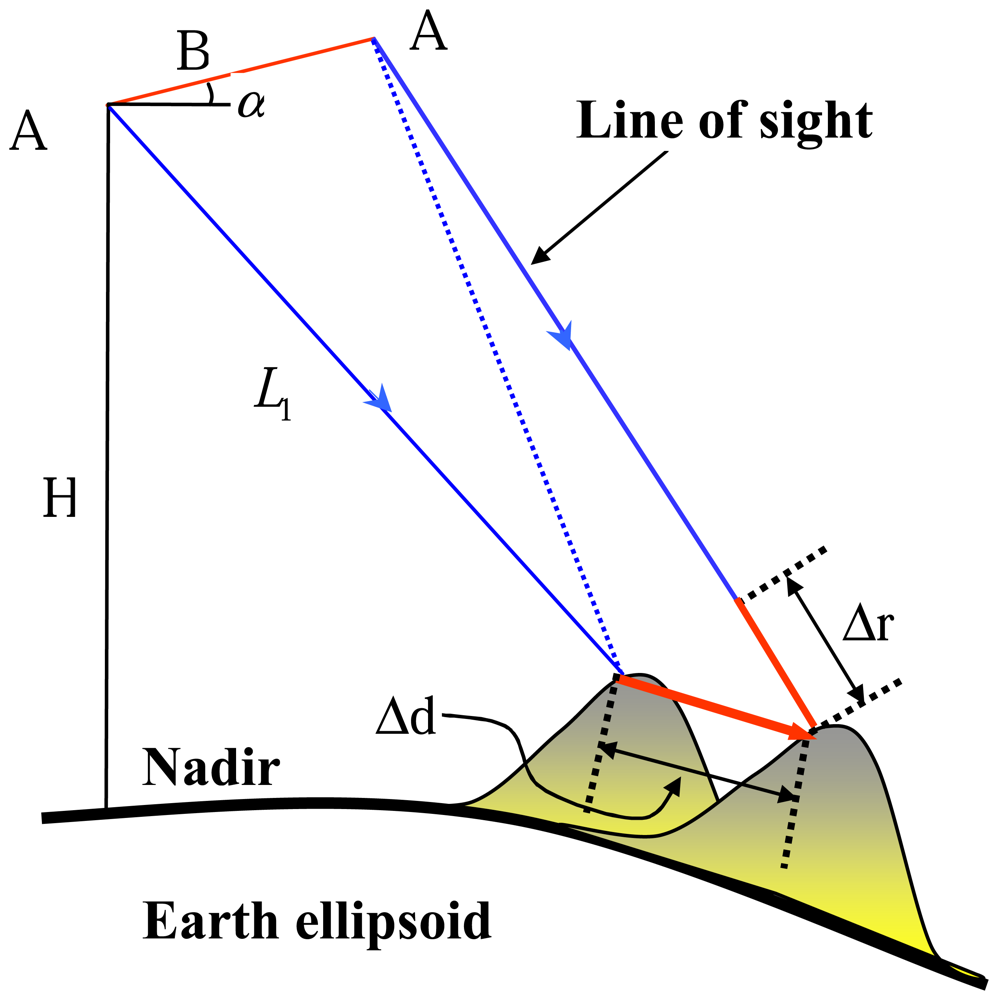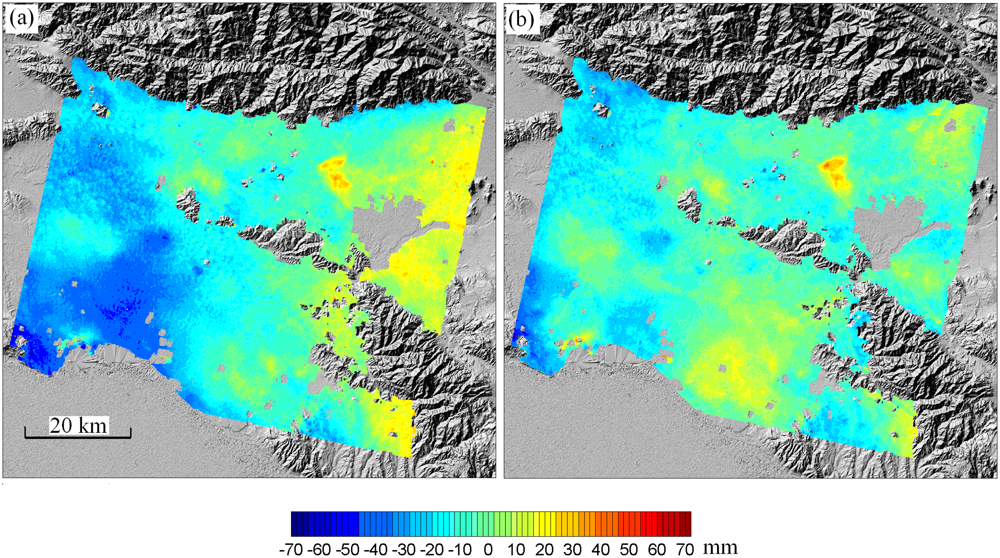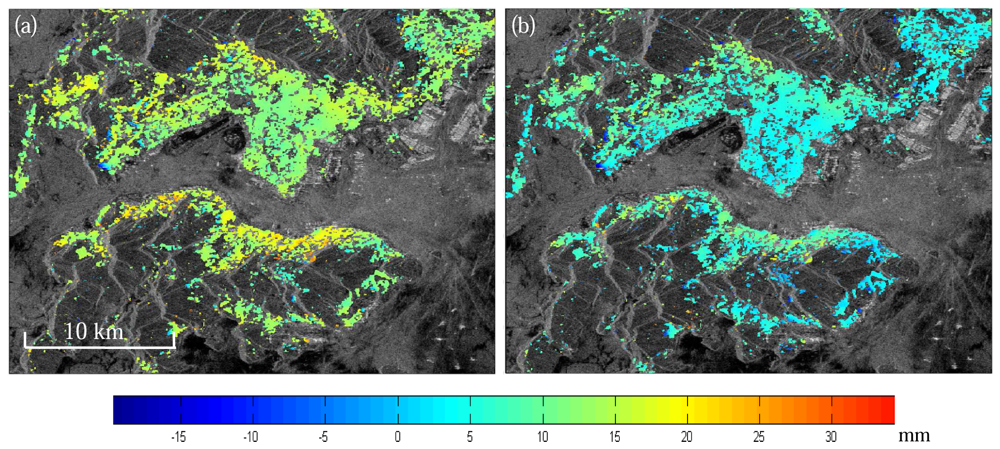Atmospheric Effects on InSAR Measurements and Their Mitigation
Abstract
:1. Introduction
2. Repeat-Pass SAR Interferometry
3. The Atmosphere and its Effects on Repeat-Pass InSAR
4. Properties of Atmospheric Signals in SAR Interferograms
4.1 Atmospheric Signals from SAR Interferograms
4.2 Anisotropic Properties of Atmospheric Signals
4.3 Gaussianity of Atmospheric Signals
4.4 Spectral Characteristics of Atmospheric Signals
5. Mitigation of Atmospheric Effects on Repeat-Pass InSAR
5.1 Correction of Atmospheric Effects based on External data
5.1.1 Correction of atmospheric effects based on ground meteorological observations
5.1.2 Correction of atmospheric effects based on GPS observations
5.1.3 Correction of atmospheric effects based on high-resolution meteorological models
5.1.4 Correction of atmospheric effects based on MODIS data
5.1.5 Correction of atmospheric effects based on MERIS data
5.2 Correction of Atmospheric Effects based on Correlation Analysis
5.3 Correction of Atmospheric Effects based on Pair-Wise Logic
5.4 Correction of Atmospheric Effects based on PSInSAR Technique
5.5 Reduction of Atmospheric Effects with the Stacking Method
6. Conclusions
Acknowledgments
References and Notes
- Rosen, P.A.; Hensley, S.; Joughin, I.R.; Li, F.K.; Madsen, S.N.; Rodriguez, E.; Goldstein, R.M. Synthetic Aperture Radar Interferometry. Proc. IEEE 2000, 88, 333–382. [Google Scholar]
- Rogers, A.E.; Ingalls, R.P. Venus: Mapping the surface reflectivity by radar interferometry. Science. 1969, 165, 797–799. [Google Scholar]
- Graham, L.C. Synthesis interferometric radar for topographic mapping. Proc. IEEE 1974, 62, 763–768. [Google Scholar]
- Zebker, H.A.; Goldstein, R.M. Topographic mapping from Interferometric Synthetic Aperture Radar Observations. J. Geophys. Res. 1986, 91, 4993–4999. [Google Scholar]
- Goldstein, R.M.; Zebker, H.A.; Werner, C.L. Satellite radar interferometry: Two-dimensional phase unwrapping. Radio Sci. 1988, 23, 713–720. [Google Scholar]
- Gabriel, A.K.; Goldstein, R.M.; Zebker, H.A. Mapping small elevation changes over large areas: differential radar interferometry. J. Geophys. Res. 1989, 94, 9183–9191. [Google Scholar]
- Massonnet, D.; Rossi, M.; Carmona, C.; Adragna, F.; Peltzer, G.; Feigl, K.L.; Rabaute, T. The displacement field of the Landers earthquake mapped by radar interferometry. Nature 1993, 364, 138–142. [Google Scholar]
- Massonnet, D.; Feigl, K.L.; Rossi, M.; Adragna, F. Radar interferometry mapping of deformation in the year after the Landers earthquake. Nature 1994, 369, 227–230. [Google Scholar]
- Zebker, H.A.; Werner, C.L.; Rosen, P.A.; Hensley, S. Accuracy of Topographic Maps Derived from ERS-1 Interferometric Radar. IEEE T. Geosci. Remote Sens. 1994, 33, 823–836. [Google Scholar]
- Zebker, H.A.; Rosen, P.A.; Goldstein, R.M.; Gabriel, A.; Werner, C.L. On the derivation of coseismic displacement fields using differential radar interferometry: The Landers Earthquake. J. Geophys. Res. 1994, 99, 19617–9634. [Google Scholar]
- Rosen, P.A.; Hensley, S.; Zebker, H.A.; Webb, F.H.; Fielding, E.J. Surface deformation and coherence measurements of Kilauea Volcano, Hawaii, from SIR-C radar interferometry. J. Geophys. Res. 1996, 101, 23109–23125. [Google Scholar]
- Lanari, R.; Fornaro, G.; Riccio, D.; Migliaccio, M.; Papathanassiou, K.P.; Moreira, J.R.; Schwabisch, M.; Dutra, L.; Puglisi, G.; Franceschetti, G.; Coltelli, M. Generation of digital elevation models by using SIR-C/X-SAR multifrequency two-pass interferometry: the Etna case study. IEEE T. Geosci. Remote Sens. 1996, 34, 1097–1114. [Google Scholar]
- Small, D. Generation of Digital Elevation Models through Spaceborne SAR Interferometry. Ph.D dissertation, University of Zurich, Zurich, 1998. [Google Scholar]
- Tobita, M.; Fujiwara, S.; Ozawa, S.; Rosen, P.A.; et al. Deformation of the 1995 North Sakhalin earthquake detected by JERS-1/SAR interferometry. Earth Planets Space 1998, 50, 313–335. [Google Scholar]
- Fujiwara, S.; Rosen, P.A.; Tobita, M.; Murakami, M. Crustal deformation measurements using repeat-pass JERS-1 Synthetic Radar Interferometry near the Izu Peninsula, Japan. J. Geophys. Res. 1998, 103(B2), 2411–2426. [Google Scholar]
- Rufino, G.; Moccia, A.; Esposito, S.D. EM generation by means of ERS Tandem Data. IEEE T. Geosci. Remote Sens. 1998, 36, 1905–1913. [Google Scholar]
- Liu, G.X.; Ding, X.L.; Chen, Y.Q.; Li, Z.L.; Li, Z.W. Monitoring land subsidence at the Chek Lap Kok Airport Using InSAR Technology. Chinese Sci. Bull 2001, 46, 1778–1782. [Google Scholar]
- Liu, G.X.; Ding, X.L.; Li, Z.L.; Li, Z.W.; Chen, Y.Q.; Yu, S.B. Pre- and Co-Seismic Ground Deformations of the 1999 Chi-Chi, Taiwan Earthquake, Measured with SAR Interferometry. Comput. Geosci. 2004, 30, 333–343. [Google Scholar]
- Ding, X.L.; Liu, G.X.; Li, Z.W.; Li, Z.L.; Chen, Y.Q. Ground subsidence monitoring in Hong Kong with satellite SAR interferometry. Photogramm. Eng. Rem. S. 2004, 70, 1151–1156. [Google Scholar]
- Zebker, H. A.; Rosen, P. A.; Hensley, S. Atmospheric effects in interferometric synthetic aperture radar surface deformation and topographic maps. J. Geophys. Res. 1997, 102, 7547–7563. [Google Scholar]
- Massonnet, D.; Feigl, K. Discrimination of geophysical phenomena in satellite radar interferograms. Geophys. Res. Lett. 1995, 22, 1537–1540. [Google Scholar]
- Tarayre, H.; Massonnet, D. Atmospheric propagation heterogeneities revealed by ERS-1. Geophys. Res. Lett. 1996, 23, 989–992. [Google Scholar]
- Li, Z.W.; Ding, X.L.; Liu, G.X.; Huang, C. Atmospheric Effects on InSAR Measurements - A Review. Geom. Res. Austr. 2003, 79, 43–58. [Google Scholar]
- Gens, R.; van Genderen, J.L. SAR interferometry- Issues, techniques, applications. Int. J. Remote Sens. 1996, 17, 1803–1835. [Google Scholar]
- Li, F.K.; Goldstein, R.M. Studies of multibaseline spaceborne interferometric synthetic aperture radars. IEEE T. Geosci. Remote Sens. 1990, 28, 88–97. [Google Scholar]
- Hanssen, R. Atmospheric heterogeneities in ERS tandem SAR interferometry; DEOS Report No.98.1; Delft University press: Delft, the Netherlands, 1998. [Google Scholar]
- Massonnet, D.; Feigl, K. Radar interferometry and its application to changes in the earth's surface. Rev. Geophys. 1998, 36, 441–500. [Google Scholar]
- Hanssen, R.F. Radar Interferometry: Data interpretation and Error Analysis; Kluwer Academic Publishers: Dordrecht, 2001. [Google Scholar]
- Delacourt, C.; Briole, P.; Achache, J. Tropospheric corrections of SAR interferograms with strong topography: application to Etna. Geophys. Res. Lett. 1998, 25, 2849–2852. [Google Scholar]
- Hanssen, R.F.; Wechwerth, T.M.; Zebker, H.A.; Klees, R. High-resolution water vapor mapping from interferometric radar measurements. Science 1999, 283, 1297–1299. [Google Scholar]
- Bracewell, R.N. Two-Dimensional Imaging; Prentice Hall: New Jersey, 1995. [Google Scholar]
- Jónsson, S. Modeling Volcano and Earthquake Deformation From Satellite Radar Interferometric Observations. Ph.D dissertation, Stanford University, 2002. [Google Scholar]
- Li, Z.W.; Ding, X.L.; Huang, C.; Zou, Z.R. Atmospheric effects on repeat-pass InSAR measurements over Shanghai region. J. Atmos. Terr. Phys. 2007, 69, 1344–1356. [Google Scholar]
- Ding, X.L.; Ge, L. L.; Li, Z.W.; Rizos, C. Atmospheric Effects on InSAR Measurements in Southern China and Australia: A Comparative Study. International Archives of the Photogrammetry, Remote Sensing and Spatial Information Science, Istanbul, Turkey, 12- 23 July. 2004; XXXV, pp. 70–75.
- Beauducel, B.; Briole, P.; Froger, J.L. Volcano-wide fringes in ERS synthetic aperture radar interferograms of ETNA (1992-1998): Deformation or tropospheric effect? J. Geophys. Res. 2000, 105, 16391–16402. [Google Scholar]
- Jarque, C.M.; Bera, A.K. Efficient tests for normality, homoscedasticity and serial independence of regression residuals. Econ. Lett. 1980, 63, 255–259. [Google Scholar]
- Hinich, M.J.; Wilson, G. R. Detection of Non-Gaussian Signals in Non-Gaussian Noise Using the Bispectrum. IEEE T. Acoust. Speech. 1990, 38, 1126–1131. [Google Scholar]
- Lohman, R.B.; Simons, M. Some thoughts on the use of InSAR data to constrain models of surface deformation: Noise structure and data downsampling. Geochem. Geophys. Geosys. 2005, 6, Q01007. [Google Scholar]
- Goldstein, R.M. Atmospheric limitations to repeat-track radar interferometry. Geophys. Res. Lett. 1995, 22, 2517–2520. [Google Scholar]
- Tatarski, V.I. Wave propagation in a turbulent medium; McGraw-Hill: New York, 1961. [Google Scholar]
- Ferretti, A.; Prati, C.; Rocca, F. Multibaseline InSAR DEM Reconstruction: The Wavelet Approach. IEEE T. Geosci. Remote Sens. 1999, 37, 705–715. [Google Scholar]
- Ferretti, A.; Prati, C.; Rocca, F. Nonlinear Subsidence Rate Estimation Using Permanent Scatters in Differential SAR Interferometry. IEEE T. Geosci. Remote Sens. 2000, 38, 2202–2212. [Google Scholar]
- Williams, S.; Bock, Y.; Fang, P. Integrated satellite interferometry: Tropospheric noise, GPS estimates and implications for interferometric synthetic aperture radar product. J. Geophys. Res. 1998, 103, 27051–27068. [Google Scholar]
- Li, Z. W.; Ding, X.L.; Huang, C.; Wadge, G.; Zheng, D.W. Modeling of atmospheric effects on InSAR measurements by incorporating terrain elevation information. J. Atmos. Terr. Phys. 2006, 66, 1189–1194. [Google Scholar]
- Li, Z. W.; Ding, X.L.; Liu, G.X. Modeling Atmospheric Effects on InSAR with Meteorological and Continuous GPS Observations: Algorithms and Some Test results. J. Atmos. Terr. Phys. 2004, 66, 907–917. [Google Scholar]
- Davis, A.; Marshak, A.; Wiscombe, W.; Cahalan, R. Scale invariance of liquid water distribution in marine stratocumulus. Part I: spectral properties and stationarity issues. J. Atmos. Sci. 1996, 53, 1538–1558. [Google Scholar]
- Emardson, T.R.; Simons, M.; Webb, F.H. Neutral atmospheric delay in interferometric synthetic aperture radar applications: Statistical description and mitigation. J. Geophys. Res. 2003, 108, 2231–2238. [Google Scholar]
- Hopfield, H. S. Tropospheric effect on electromagnetically measured range: Prediction from surface weather data. Radio Sci. 1971, 6, 357–367. [Google Scholar]
- Saastamoinen, J. Atmospheric correction for troposphere and stratosphere in radio ranging of satellites. The use of artificial satellites for Geodesy. Gephys. Monogr. Ser. 1972, 247–251. [Google Scholar]
- Askne, J.; Nordius, H. Estimation of tropospheric delay for microwaves from surface weather data. Radio Sci. 1987, 22, 379–386. [Google Scholar]
- Baby, H.B.; Gole, P.; Lavergnat, J. A model for the tropospheric excess path length of radio waves from surface meteorological measurements. Radio Sci. 1988, 23, 1023–1038. [Google Scholar]
- Li, Z.W.; Ding, X.L.; Chen, W.; Liu, G.X.; Shea, Y.K.; Emerson, N. Comparative study of tropospheric empirical model for Hong Kong region. Surv. Rev. 2008, in press. [Google Scholar]
- Hanssen, R.; Feijt, A. A first quantitative evaluation of atmospheric effects on SAR interferometry. Fringe 96′ Workshop on ERS SAR Interferometry, Zurich, Switzerland, 30 Sep.-2 Oct. 1996; pp. 277–282. [Google Scholar]
- Bonforte, A.; Ferretti, A.; Prati, C.; Puglisi, G.; Rocca, F. Calibration of atmospheric effects on SAR interferograms by GPS and local atmosphere models: first results. J. Atmos. Terr. Phys. 2001, 63, 1343–1357. [Google Scholar]
- Bevis, M.; Businger, S.; Herring, T.A.; Rocken, R.; Anthes, R.A.; Ware, R.H. GPS Meteorology: Remote sensing of atmospheric water vapor using the Global Positioning System. J. Geophys. Res. 1992, 97, 15787–15801. [Google Scholar]
- Liu, Y. Remote Sensing of Water Vapor Content Using GPS Data in Hong Kong Region. Ph.D dissertation, Hong Kong Polytechnic University, Hung Hom, 1999. [Google Scholar]
- Bock, Y.; Williams, S. Integrated Satellite Interferometry in Southern California. EOS 1997, 78(29). [Google Scholar]
- Janssen, V.; Ge, L.L.; Rizos, C. Tropospheric correction to SAR interferometry from GPS observations. GPS Solut. 2004, 8, 140–151. [Google Scholar]
- Webley, P.W.; Bingley, R.M.; Dodson, A.H.; Wadge, G.; Waugh, S.J.; James, I.N. Atmospheric water vapor correction to InSAR surface motion measurements on mountains: results from a dense GPS network on Mount Etna. Phys. Chem. Earth. 2002, 27, 363–370. [Google Scholar]
- Li, Z.H.; Fielding, E.J.; Cross, P.; Muller, J.-P. Interferometric synthetic aperture radar atmospheric correction: GPS topography-dependent turbulence model. J. Geophys. Res. 2006, 111, B02404. [Google Scholar] [CrossRef]
- Onn, F.; Zebker, H.A. Correction for interferometric synthetic aperture radar atmospheric phase artifacts using time series of zenith wet delay observations from a GOS network. J. Geophys. Res. 2006, 111, B09102. [Google Scholar] [CrossRef]
- Onn, F. Modeling water vapor using GPS with application to mitigating InSAR atmospheric distortions. Ph.D dissertation, Stanford University, 2006; p. 176. [Google Scholar]
- Wadge, G.; Webley, P.W.; James, I.N.; Bingley, R.; Dodson, A.; Waugh, S.; Veneboer, T.; Puglisi, G.; Mattia, M.; Baker, D.; Edwards, S.C.; Edwards, S.J.; Clarke, P.J. Atmospheric models, GPS and InSAR measurements of the tropospheric water vapor fields over Mount Etna. Geophys. Res. Lett. 2002, 29, 1905–1908. [Google Scholar]
- Webley, P.W.; Wadge, G.; James, I.N. Determining radio wave delay by non-hydrostatic atmospheric modeling of water vapour over mountains. Phys. Chem. Earth. 2004, 29, 139–148. [Google Scholar]
- Webley, P.W. Atmospheric water vapor correction to InSAR surface motion measurements on mountains: Case Study on Mount Etna. Ph.D dissertation, University of Reading, UK, Reading, 2003. [Google Scholar]
- Foster, J.; Brooks, B.; Cherubini, T.; Shacat, C.; Businger, S.; Werner, C. Mitigating atmospheric noise for InSAR using a high resolution weather model. Geophys. Res. Lett. 2006, 33, L16304. [Google Scholar]
- Puysségur, B.; Michel, R.; Avouac, J.-P. Tropospheric phase delay in interferometric synthetic aperture radar estimated from meteorological model and multispectral imagery. J. Geophys. Res. 2007, 112, B05419. [Google Scholar]
- Gao, B.-C.; Kaufman, Y.J. Water vapor retrievals using Moderate Resolution Imaging Spectroradiometer (MODIS) near-infrared channels. J. Geophys. Res. 2003, 108, 4389–4398. [Google Scholar]
- Li, Z.H.; Muller, J.P.; Cross, P. Tropospheric correction techniques in repeat-pass SAR interferometry. Proceedings of the FRINGE 2003 workshop, Frascati, Italy, 1- 5, December 2003.
- Li, Z.H.; Muller, J.-P.; Cross, P.; Fielding, E.J. Interferometric synthetic aperture radar (InSAR) atmospheric correction: GPS, Moderate Resolution Imaging Spectroradiometer (MODIS), and InSAR integration. J. Geophys. Res. 2005, 110, B03410. [Google Scholar]
- Journel, A.G.; Kyriakidis, P.C.; Mao, S. Correcting the Smoothing Effect of Estimators: A Spectral Postprocessor. Math. Geol. 2000, 32, 787–813. [Google Scholar]
- Li, Z. W. Modeling atmospheric effects on repeat-pass InSAR measurements. Ph.D Dissertation, The Hong Kong Polytechnic University, Hong Kong, 2005; p. 143. [Google Scholar]
- Li, Z. H.; Muller, J. P.; Cross, P.; Albert, P.; Fischer, J.; Bennartz, R. Assessment of the potential of MERIS near-infrared water vapour products to correct ASAR interferometric measurements. Int. J. Remote Sens. 2006, 27, 349–365. [Google Scholar]
- Li, Z.H.; Fielding, E.J.; Cross, P.; Muller, J.P. Interferometric synthetic aperture radar atmospheric correction: Medium Resolution Imaging Spectrometer and Advanced Synthetic Aperture Radar integration. Geophys. Res. Lett. 2006, 33, L06816. [Google Scholar]
- Sarti, F.; Vadon, H.; Massonnet, D. A method for the automatic characterization of atmospheric artifacts in SAR interferograms by correlation of multiple interferograms over the same site. Proceedings of IGARRS'99, Hamburg, Germany, 28 June- 2 July 1999.
- Fruneau, B.; Sarti, F. Detection of ground subsidence in the city of Paris using radar interferometry: isolation of deformation from atmospheric artifact using correlation. Geophys. Res. Lett. 2000, 27, 3981–3984. [Google Scholar]
- Sarti, F.; Fruneau, B.; Cunha, T. Isolation of atmospheric artifacts in differential interferometry for ground displacement detection: comparison of different methods. Proceedings of the European Space Agency ERS-Envisat Symposium, Gothenburg, Sweden, 16 - 20 October 2000.
- Remy, D.; Bonvalot, S.; Briole, P.; Murakami, M. Accurate measurements of tropospheric effects in volcanic areas from SAR interferometry data: application to Sakurajima volcano (Japan). Earth Planet. Sci. Lett. 2003, 213, 299–310. [Google Scholar]
- Ferretti, A.; Prati, C.; Rocca, F. Permanent Scatters in SAR interferometry. IEEE T. Geosci. Remote Sens. 2001, 39, 8–20. [Google Scholar]
- Hooper, A.; Zebker, H.; Segall, P.; Kampes, B. A new method for measuring deformation on volcanoes and other natural terrains using InSAR persistent scatterers. Geophys. Res. Lett. 2004, 31, L23611. [Google Scholar]
- Chaabane, F.; Avallone, A.; Tupin, F.; Briole, P.; Maître, H. A Multitemporal Method for Correction of Tropospheric Effects in Differential SAR Interferometry: Application to the Gulf of Corinth Earthquake. IEEE T. Geosci. Remote Sens. 2007, 45, 1605–1615. [Google Scholar]
- Ferreti, A.; Novali, F.; Passera, E.; Prati, C.; Rocca, F. Statistical analysis of atmospherical components in ERS SAR data. In Fringe'05; Esrin, Prascati; 28 November - 2 December 2005.
- Curlander, J.C.; McDonough, R.N. Synthetic Aperture Radar: Systems and Signal Processing.; Wiley: New York, 1991. [Google Scholar]






© 2008 by the authors; licensee Molecular Diversity Preservation International, Basel, Switzerland. This article is an open-access article distributed under the terms and conditions of the Creative Commons Attribution license (http://creativecommons.org/licenses/by/3.0/).
Share and Cite
Ding, X.-l.; Li, Z.-w.; Zhu, J.-j.; Feng, G.-c.; Long, J.-p. Atmospheric Effects on InSAR Measurements and Their Mitigation. Sensors 2008, 8, 5426-5448. https://doi.org/10.3390/s8095426
Ding X-l, Li Z-w, Zhu J-j, Feng G-c, Long J-p. Atmospheric Effects on InSAR Measurements and Their Mitigation. Sensors. 2008; 8(9):5426-5448. https://doi.org/10.3390/s8095426
Chicago/Turabian StyleDing, Xiao-li, Zhi-wei Li, Jian-jun Zhu, Guang-cai Feng, and Jiang-ping Long. 2008. "Atmospheric Effects on InSAR Measurements and Their Mitigation" Sensors 8, no. 9: 5426-5448. https://doi.org/10.3390/s8095426



